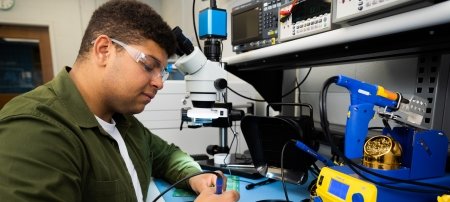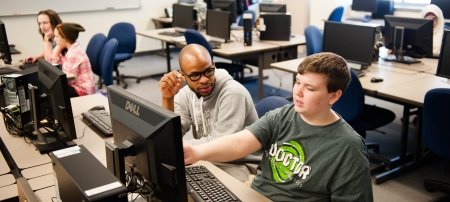Michigan Tech Enrollment Exceeds Expectations: Diversity and Graduate Student Numbers Increase
Michigan Technological University enrollment has topped projected numbers for the fall semester. Data reported to the State Budget Office last night show that the public research university’s enrollment totaled 6,957, including 5,716 undergraduates and 1,241 graduate students.
Last fall, Michigan Tech’s total enrollment was 7,132, including 1,189 graduate students.
“We planned for total enrollment this fall of 6,900 and we exceeded that goal,” said Michigan Tech President Glenn D. Mroz. “We're particularly pleased that emphasis on graduate enrollment continues to raise graduate student numbers to their highest level ever at Michigan Tech.”
Since 2007, Michigan Tech has intentionally been working to increase its proportion of graduate students, from 13 percent to 18 percent of the student body.
“The main factors affecting our expected undergraduate enrollment this year included an unusually large graduating class last year and the discontinuation of the Michigan Promise Grant,” Mroz said.
Les Cook, vice president for student affairs, agreed. “We know students and their families are struggling with increased costs, and in particular, the loss of the Michigan Promise Grant,” he said. “We saw the effect on our students last year, and we made up the difference in financial aid, essentially keeping the promise. We're working with students one on one this year to make up the Promise Grant where needed, but we are simply not able to do that for everyone. That, I'm sure, has affected some students’ decisions about their university enrollment.”
Another factor in undergraduate enrollment may be an increase in tuition, based on an expected drop in state support, but “we have promised our Michigan resident students that if the state comes through with more money than we anticipated in our budget, we will provide a rebate on a portion of tuition,” Mroz said.
The diversity of the student body at Michigan Tech, including minorities and international students, increased to 20 percent. “Despite a sluggish economy, which tends to affect lower-income and minority students disproportionately, our numbers are up,” said Mroz. “I think that’s a testament to the intensive efforts we make to expose students from different backgrounds to Tech and to encourage them to seriously consider the STEM (science, technology, engineering and math) degree programs that are in high demand in the job market.“ He mentioned University initiatives such as summer youth programs that recruit urban high school students, particularly in the Detroit area, and increases in financial aid.
Female enrollment also rose, from 25 to 26 percent.
The enrollment report showed that Tech’s average ACT score has risen more than one entire point, from 25.1 to 26.1, since 2005. With ACT scores ranging from 1 to 36, moving up a whole point reflects a significant increase in numbers of high-scoring entering students. Michigan’s average ACT score statewide this year was 19.7, and the national average was 21.
"The average ACT score is significant because a higher score indicates that Michigan Tech is attracting more high-achieving students and a broader array of students,” said Vice President Cook. The ACT score is also an important factor in US News rankings of colleges and universities.
“The increase in our average ACT score shows that smart students are drawn to other smart students,” added John Lehman, assistant vice president for enrollment.
The English ACT score of first-year students entering Michigan Tech has shown the most significant change over the years, rising from 23.7 in 2005 to 25.1 this year. Lehman attributed the rise to increasing numbers of students in the School of Forest Resources and Environmental Science and the College of Sciences and Arts. “People are recognizing us for our strong programs in addition to engineering,” he said.
Michigan Technological University is a public research university founded in 1885 in Houghton, Michigan, and is home to more than 7,000 students from 55 countries around the world. Consistently ranked among the best universities in the country for return on investment, Michigan’s flagship technological university offers more than 120 undergraduate and graduate degree programs in science and technology, engineering, computing, forestry, business and economics, health professions, humanities, mathematics, social sciences, and the arts. The rural campus is situated just miles from Lake Superior in Michigan's Upper Peninsula, offering year-round opportunities for outdoor adventure.




Comments